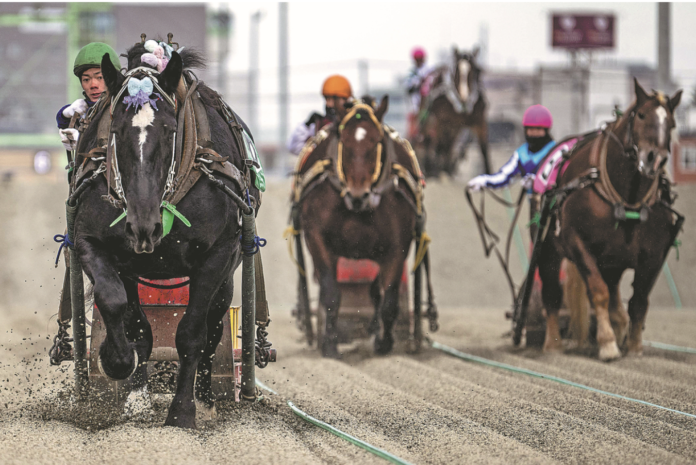OBIHIRO, Japan — At a unique racecourse in Japan, speed takes a backseat as the suspenseful, stop-and-start drama of the world’s slowest horse race gains popularity, attracting new fans eager to place bets on their favorite sturdy contenders.
- A fanfare sets the stage as gates swing open, initiating the race. However, instead of a gallop, horses move at a deliberate plod, towing heavy sleighs in a century-old tradition.
- The Banei Keiba races unfold in Obihiro, a city in Hokkaido, Japan’s northern region, where spectators enthusiastically cheer on muscular workhorses, maintaining a pace akin to a brisk human walk.
- Eight equine competitors kick up dust on the 200-meter track, powering over the first of two mounds during a recent afternoon. However, their progress includes halts and breaks, allowing them to catch their breath in the winter air.
- “It builds a little bit of suspense,” remarks 24-year-old Australian tourist Esther McCourt, highlighting the unpredictability of the races. She emphasizes that, regardless of initial appearances, the crucial part is the last 50 meters, where outcomes can change at any moment.
- The popularity of Banei Keiba experienced a decline until renewed marketing efforts coincided with a surge of interest during the pandemic. Casual gamblers and dedicated fans, watching races and placing bets online, have contributed to annual sales reaching $370 million—a fivefold increase from the low point in 2011.
Facts about Horse Racing in Japan:
- The Banei Keiba races in Obihiro, Japan, are known for their unconventional, slow-paced style, deviating from the typical high-speed horse racing seen in other parts of the world.
- The tradition of Banei Keiba developed in Hokkaido, Japan, during the migration of Japanese settlers. Horses known as banba were integral for various tasks, including field clearing, goods transportation, and mining operations.
- The banba horses used in Banei Keiba are distinctively larger and heavier than traditional racing thoroughbreds. These workhorses are twice the weight of their racing counterparts.
- The races involve horses pulling sleighs weighing over 600 kilograms, adding an extra layer of physical challenge and spectacle to the event.
- Despite facing financial challenges and a decline in interest, the Obihiro Racecourse, now the sole custodian of Banei Keiba, successfully revived the tradition by attracting more diverse audiences, making the facility smoke-free, and emphasizing family-friendly and tourist-oriented initiatives.
In conclusion, the captivating allure of the world’s slowest horse race, the Banei Keiba in Obihiro, Japan, has not only endured but experienced a remarkable resurgence in popularity. The unique spectacle of horses plodding rather than galloping, towing heavy sleighs in a tradition rooted in history, has captured the fascination of both new enthusiasts and dedicated fans. The deliberate pace, strategic breaks, and the suspenseful finish, as highlighted by spectators like Australian tourist Esther McCourt, contribute to the charm of the event.
The decline in Banei Keiba’s popularity, a trend observed until recent times, witnessed a remarkable turnaround with well-timed marketing efforts coinciding with a surge of interest during the pandemic. The integration of online betting options further fueled the revival, propelling the event’s annual sales to an impressive $370 million—a remarkable fivefold increase from its low point in 2011.
The historical roots of Banei Keiba, stemming from the reliance on horses during the migration of Japanese settlers to Hokkaido, add cultural depth to the tradition. The banba horses, twice the weight of traditional racing thoroughbreds, symbolize the resilience and strength of these workhorses, contributing to the unique nature of the races.
While three other cities in the region discontinued similar races in 2006 due to financial challenges, Obihiro Racecourse emerged as the sole custodian of this tradition. The revitalization efforts, including making the facility family-friendly and smoke-free, have not only sustained the tradition but also attracted a diverse audience, ensuring its continuation.
Currently boasting about 750 horses, tended to by a dedicated team of 28 trainers, 150 caretakers, and 21 jockeys, Banei Keiba stands as a testament to the enduring spirit of a centuries-old tradition that has found new life, captivating audiences and enthusiasts alike.





